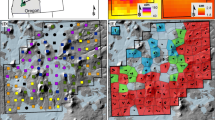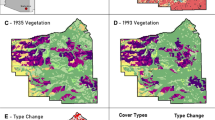Abstract
Climate and topography are two important controls on spatial patterns of fire disturbance in forests globally, via their influence on fuel moisture and fuel production. To assess the influences of climate and topography on fire disturbance patterns in a temperate forest region, we analyzed the mapped perimeters of fires that burned during 1930–2003 in two national parks in the eastern United States. These were Great Smoky Mountains National Park (GSMNP) in the southern Appalachian Mountains and Shenandoah National Park (SNP) in the central Appalachian Mountains. We conducted GIS analyses to assess trends in area burned under differing climatic conditions and across topographic gradients (elevation, slope position, and aspect). We developed a Classification and Regression Tree model in order to further explore the interactions between topography, climate, and fire. The results demonstrate that climate is a strong driver of both spatial and temporal patterns of wildfire. Fire was most prevalent in the drier SNP than the wetter GSMNP, and during drought years in both parks. Topography also influenced fire occurrence, with relatively dry south-facing aspects, ridges, and lower elevations burning most frequently. However, the strength of topographic trends varied according to the climatic context. Weaker topographic trends emerged in the drier SNP than GSMNP, and during low-PDSI (dry) years than high-PDSI (wet) years in both parks. The apparent influence of climate on the spatial patterning of fire suggests a more general concept, that disturbance-prone landscapes exhibit weaker fine-scale spatial patterning of disturbance than do less disturbance-prone landscapes.










Similar content being viewed by others
References
Abrams MD, Nowacki GJ (2008) Native Americans as active and passive promoters of mast and fruit trees in the eastern USA. Holocene 18:1123–1137
Aldrich SR, Lafon CW, Grissino-Mayer HD, DeWeese GG, Hoss JA (2010) Three centuries of fire in montane pine-oak stands on a temperate forest landscape. Appl Veg Sci 13:36–46
Baker WL (2003) Fires and climate in forested landscapes of the U.S. Rocky Mountains. In: Veblen TT, Baker WL, Montenegro G, Swetnam TW (eds) Fire and climatic change in temperate ecosystems of the western Americas. Springer-Verlag, New York, pp 120–157
Beckage B, Platt WJ, Slocum MG, Pank B (2003) Influence of the El Nino Southern Oscillation on fire regimes in the Florida everglades. Ecology 84:3124–3130
Bigler C, Kulakowski D, Veblen TT (2005) Multiple disturbance interactions and drought influence fire severity in rocky mountain subalpine forests. Ecology 86:3018–3029
Boose ER, Serrano MI, Foster DR (2004) Landscape and regional impacts of hurricanes in Puerto Rico. Ecol Monogr 74:335–352
Bourg NA, McShea WJ, Gill DE (2005) Putting a cart before the search: successful habitat prediction for a rare forest herb. Ecology 86:2793–2804
Breiman L, Friedman JH, Olshen RA, Stone CG (1984) Classification and regression trees. Chapman and Hall, New York
Brown PM, Kaufmann MR, Shepperd WD (1999) Long-term, landscape patterns of past fire events in a montane ponderosa pine forest of central Colorado. Landscape Ecol 14:513–532
Chen M, Pollard D, Barron EJ (2003) Comparison of future climate change over North America simulated by two regional models. J Geophys Res Atmos 108:19
Cyr D, Gauthier S, Bergeron Y (2007) Scale-dependent determinants of heterogeneity in fire frequency in a coniferous boreal forest of eastern Canada. Landscape Ecol 22:1325–1339
Daly C, Neilson RP, Phillips DL (1994) A statistical topographic model for map** climatological precipitation over mountainous terrain. J Appl Meteorol 33:140–158
Delcourt PA, Delcourt HR (1998) The Influence of prehistoric human-set fires on oak-chestnut forests in the southern Appalachians. Castanea 63:337–345
Drever CR, Drever MC, Messier C, Bergeron Y, Flannigan M (2008) Fire and the relative roles of weather, climate and landscape characteristics in the Great Lakes St. Lawrence forest of Canada. J Veg Sci 19:57–66
Dubayah R, Rich PM (1995) Topographic solar-radiation models for GIS. Int J Geogr Inf Syst 9:405–419
ESRI (2006) ArcMap. Environmental Systems Research Institute, Inc., Redlands
Fenneman NM (1938) Physiography of eastern United States. McGraw Hill Book Company, New York
Fesenmyer KA, Christensen NL (2010) Reconstructing holocene fire history in a southern Appalachian forest using soil charcoal. Ecology 91:662–670
Foster DR, Knight DH, Franklin JF (1998) Landscape patterns and legacies resulting from large, infrequent forest disturbances. Ecosystems 1:497–510
Grissino-Mayer HD, Romme WH, Floyd ML, Hanna DD (2004) Climatic and human influences on fire regimes of the southern San Juan Mountains, Colorado, USA. Ecology 85:1708–1724
Heinselman ML (1973) Fire in the virgin forests of the Boundary Waters Canoe Area, Minnesota. Quat Res 3:329–382
Heyerdahl EK, Brubaker LB, Agee JK (2001) Spatial controls of historical fire regimes: a multiscale example from the interior west, USA. Ecology 82:660–678
Hoss JA, Lafon CW, Grissino-Mayer HD, Aldrich SR, DeWeese GG (2008) Fire history of a temperate forest with an endemic fire-dependent herb. Phys Geogr 29:424–441
Howe E, Baker WL (2003) Landscape heterogeneity and disturbance interactions in a subalpine watershed in northern Colorado, USA. Ann Assoc Am Geogr 93:797–813
Insightful Corporation (2001) S-Plus for Windows user’s guide and software program. Insightful Corporation, Seattle
Kafka V, Gauthier S, Bergeron Y (2001) Fire impacts and crowning in the boreal forest: study of a large wildfire in western Quebec. Int J Wildland Fire 10:119–127
Klingseisen B, Metternicht G, Paulus G (2008) Geomorphometric landscape analysis using a semi-automated GIS-approach. Environ Model Softw 23:109–121
Lafon CW, Grissino-Mayer HD (2007) Spatial patterns of fire occurrence in the central Appalachian Mountains and implications for wildland fire management. Phys Geogr 28:1–20
Lafon CW, Hoss JA, Grissino-Mayer HD (2005) The contemporary fire regime of the central Appalachian Mountains and its relation to climate. Phys Geogr 26:126–146
Lutgens FK, Tarbuck EJ (2007) The atmosphere, 10th edn. Prentice Hall, Upper Saddle River
Mermoz M, Kitzberger T, Veblen TT (2005) Landscape influences on occurrence and spread of wildfires in Patagonian forests and shrublands. Ecology 86:2705–2715
Mitchener LJ, Parker AJ (2005) Climate, lightning, and wildfire in the national forests of the southeastern United States: 1989–1998. Phys Geogr 26:147–162
Morgan P, Hardy CC, Swetnam TW, Rollins MG, Long DG (2001) Map** fire regimes across time and space: understanding coarse and fine-scale fire patterns. Int J Wildland Fire 10:329–342
Moritz MA (2003) Spatiotemporal analysis of controls on shrubland fire regimes: age dependency and fire hazard. Ecology 84:351–361
NCDC (2002) Climatography of the United States, no. 81. NOAA National Climatic Data Center, Asheville
Odion DC, Frost EJ, Strittholt JR, Jiang H, Dellasala DA, Moritz MA (2004) Patterns of fire severity and forest conditions in the western Klamath Mountains, California. Conserv Biol 18:927–936
Palmer WC (1965) Meteorological drought. Research Paper no. 45. US Weather Bureau, Washington
Parisien MA, Peters VS, Wang YH, Little JM, Bosch EM, Stocks BJ (2006) Spatial patterns of forest fires in Canada, 1980–1999. Int J Wildland Fire 15:361–374
Parker KC, Bendix J (1996) Landscape-scale geomorphic influences on vegetation patterns in four environments. Phys Geogr 17:113–141
Petersen SM, Drewa PB (2006) Did lightning-initiated growing season fires characterize oak-dominated ecosystems of southern Ohio? J Torrey Bot Soc 133:217–224
Rollins MG, Morgan P, Swetnam T (2002) Landscape-scale controls over 20(th) century fire occurrence in two large Rocky Mountain (USA) wilderness areas. Landscape Ecol 17:539–557
Schulte LA, Mladenoff DJ, Burrows SN, Sickley TA, Nordheim EV (2005) Spatial controls of pre-Euro-American wind and fire disturbance in northern Wisconsin (USA) forest landscapes. Ecosystems 8:73–94
Shanks RE (1954) Climates of the Great Smoky Mountains. Ecology 35:354–361
Shapiro-Miller LB, Heyerdahl EK, Morgan P (2007) Comparison of fire scars, fire atlases, and satellite data in the northwestern United States. Can J For Res 37:1933–1943
Sibold JS, Veblen TT (2006) Relationships of subalpine forest fires in the Colorado Front Range with interannual and multidecadal-scale climatic variation. J Biogeogr 33:833–842
Sokal RR, Rohlf FJ (2003) Biometry: the principles and practice of statistics in biological research, 3rd edn. W.H. Freeman and Company, New York
Stephens SL, Ash AN, Stauffer DF (1993) Appalachian oak forests. In: Martin WH, Boyce SG, Esternacht AC (eds) Biodiversity of the southeastern United States: upland terrestrial communities. Wiley, New York, pp 255–304
Stueve KM, Lafon CW, Isaacs RE (2007) Spatial patterns of ice storm disturbance on a forested landscape in the Appalachian Mountains, Virginia. Area 39:20–30
Swetnam TW, Betancourt JL (1998) Mesoscale disturbance and ecological response to decadal climatic variability in the American southwest. J Clim 11:3128–3147
Takle ES, Bramer DJ, Heilman WE, Thompson MR (1994) A synoptic climatology for forest-fires in the NE US and future implications from GSM simulations. Int J Wildland Fire 4:217–224
Taylor AH, Skinner CN (1998) Fire history and landscape dynamics in a late-successional reserve, Klamath Mountains, California, USA. For Ecol Manag 111:285–301
Thornthwaite CW (1948) An approach toward a rational classification of climate. Geogr Rev 38:55–94
Turner MG, Hargrove WW, Gardner RH, Romme WH (1994) Effects of fire on landscape heterogeneity in Yellowstone-National-Park, Wyoming. J Veg Sci 5:731–742
Veblen TT, Kitzberger T, Donnegan J (2000) Climatic and human influences on fire regimes in ponderosa pine forests in the Colorado Front Range. Ecol Appl 10:1178–1195
Venables WN, Ripley BD (1999) Modern applied statistics with S-PLUS. Springer, New York
Weisberg PJ (2004) Importance of non-stand-replacing fire for development of forest structure in the Pacific Northwest, USA. For Sci 50:245–258
Wimberly MC, Reilly MJ (2007) Assessment of fire severity and species diversity in the southern Appalachians using Landsat TM and ETM plus imagery. Remote Sens Environ 108:189–197
Zar JH (1999) Biostatistical analysis, 4th edn. Pearson Education, Delhi
Zhang QF, Pregitzer KS, Reed DD (1999) Catastrophic disturbance in the presettlement forests of the Upper Peninsula of Michigan. Can J For Res 29:106–114
Acknowledgments
We thank the personnel at Great Smoky Mountains National Park and Shenandoah National Park, in particular the GIS coordinators Benjamin Zank and Dan Hurlbert, and the fire managers that recorded and mapped fires over the past 70 years. We also thank Dr. David Cairns for guidance with the model analysis and Maria Tchakerian and Chen Xu for guidance in data processing. The manuscript was improved with the comments of two anonymous reviewers. This research was supported by the National Interagency Fire Center’s Joint Fire Science Program, project number 06-3-1-05.
Author information
Authors and Affiliations
Corresponding author
Rights and permissions
About this article
Cite this article
Flatley, W.T., Lafon, C.W. & Grissino-Mayer, H.D. Climatic and topographic controls on patterns of fire in the southern and central Appalachian Mountains, USA. Landscape Ecol 26, 195–209 (2011). https://doi.org/10.1007/s10980-010-9553-3
Received:
Accepted:
Published:
Issue Date:
DOI: https://doi.org/10.1007/s10980-010-9553-3




